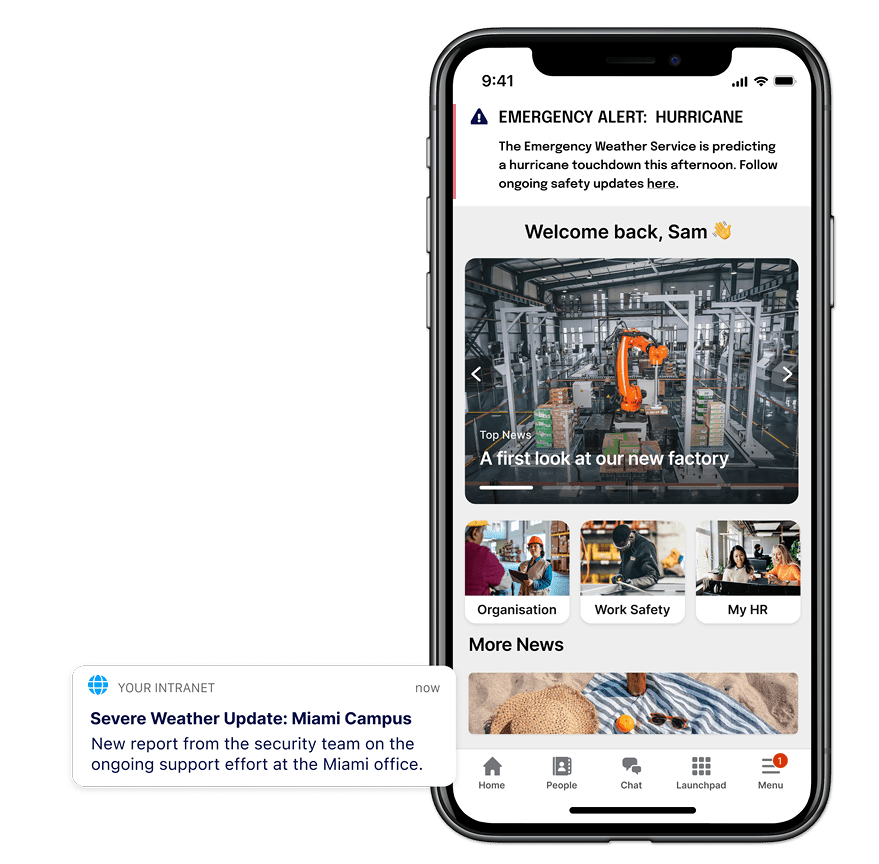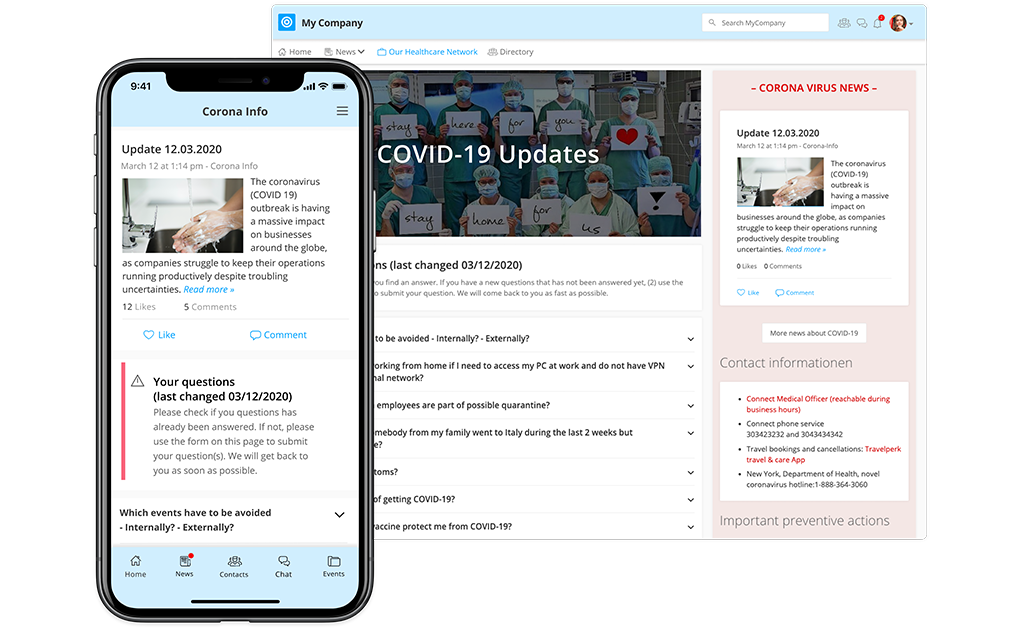What Is Crisis Communication? Everything You Need to Know
Crises are unavoidable. Being prepared and ready to respond can be the difference between whether your organization sinks or swims.

Crises often hit without warning — so preparing in advance is crucial. In this article, we explore everything you need to know about strategic crisis communication to keep control of the narrative and effectively manage ongoing crisis situations.
What is crisis communication?
Crisis communication is the practice of strategic communication about emergency situations or critical events. It includes communication with both external and internal stakeholders (i.e. your employees). Effective crisis communication is essential in situations that could damage your company’s reputation, disrupt operations, or harm stakeholder and employee trust. The goal of crisis communications is to provide clear information, minimize damage, and maintain trust in your organization.
The importance of communication in crisis management
Communication with both external and internal parties is a crucial part of crisis management. Effective communication with customers, employees, partners, and other stakeholders helps to provide clarity and direction in an otherwise uncertain and confusing situation. Depending on the circumstances, it may also be necessary to communicate publicly, either through traditional media outlets or on social media.
Effective crisis communication should inspire trust in your organization and its ability to overcome the challenges it’s currently facing. Clear and consistent messaging that keeps the relevant people informed throughout a developing crisis is also vital in enabling recovery and business continuity after the situation is resolved.
How to create a winning crisis communication plan
No matter the specifics, crisis situations are incredibly stressful for those involved. And thinking clearly and making effective decisions is almost impossible when you’re in the midst of an ongoing crisis.
To ensure your crisis communications are effective, it’s a good idea to have a solid crisis communication plan in place before a crisis arises. Your crisis communication plan should provide you with all the relevant information you need to effectively manage the crisis, so you don’t need to worry about tracking down contact details or designating company spokespeople while the crisis is developing.
A step-by-step guide to putting your crisis communication plan together
An effective crisis communication plan ensures you’re prepared to face any situation, whether it’s a natural disaster, a technological failure, or a pandemic. Keep reading to learn how to put your plan together.
What is a crisis communication plan?
A crisis communication plan (or crisis management plan) is a set of guidelines that businesses use to communicate both internally and externally about emergencies or unexpected events. It should include the steps the company will take when the crisis first emerges, as well as a list of stakeholders who need to be kept informed. Having an effective crisis communication plan in place enables companies to respond quickly when a crisis emerges and ensures consistent messaging across all communications channels.
Here are the steps to follow to create your crisis communication plan:
Determine the goal of your crisis communication plan
The first step in putting your crisis communication plan together is to clarify what the plan is for. Documenting the goal of your plan at an early stage is an important exercise, as the objective you decide upon will guide you throughout the rest of the process. For example, you may write down something like:
“The goal of the crisis communication plan is to create a structure for communicating with all relevant stakeholders in the event of a crisis that impacts business function or the company’s reputation.”
This is a simple example, but you can choose to go into more detail about the specific aims of your crisis communication plan if you want to.
Identify the most likely crisis situations
There are many different situations that could constitute a crisis, including natural disasters, operational failures, and public scandals. The likelihood of each scenario depends on the nature of your business and its operations.
Because different crises require different responses, it’s useful to have an idea of the type of situations you could be faced with. Taking the time to brainstorm and pinpoint the most probable threats lays the groundwork for effective communication and crisis management. The goal is to reduce panic when disaster strikes, allowing your team to stay calm and focused, and react swiftly and effectively to the crisis.
Establish monitoring and reporting channels
In crisis management, the ability to act quickly and proactively is crucial. The faster you can spot a problem emerging, the better your chances of taking control before it escalates. That’s why it’s important to set up systems that allow you to identify potential problems as early as possible. By closely monitoring social media, news outlets, and other relevant sources, you’ll be in a better position to detect the early warning signs of an issue that could impact your business.
As well as identifying problems, you also need to set up a clear process for getting information to the right people as quickly as possible. The person who first notices a crisis in the making may not be the one responsible for dealing with it, so establishing internal reporting channels and a clear chain of communication is essential. For example, your protocol might be to notify the CEO first, followed by your head of communications or PR.
Assemble a crisis communication team
Effectively handling an unexpected event requires input from more than one department. To maximize your chances of success, put together a strong crisis communication team made up of professionals from key departments like communications, PR, social media, legal, and customer support. Including a C-suite representative on your team can help to ensure top-level alignment when a crisis hits.
Your crisis communications plan should include a list of the relevant people and their contact details, so you don’t need to waste time looking for phone numbers in an emergency. It’s also a good idea to add all team members to a group chat or channel so that you can communicate easily in times of crisis.
This is also the moment to assign specific roles and responsibilities to each team member, ensuring that everyone knows what they need to do in the event of an emergency. For example, one person may be in charge of social media communications, while someone else is responsible for drafting a public statement.
Identify the relevant stakeholders
A key part of crisis preparedness is knowing exactly who you need to inform when things go wrong. Listing the relevant stakeholders in your crisis communication plan ensures you have all your bases covered and won’t leave anyone out of the loop when you’re under the pressure of an ongoing crisis. The relevant stakeholders vary from one company to another, but might include:
Employees
Customers or users
Partners
Investors
Media outlets
Governments and regulatory bodies
The general public
Your crisis communications plan should include the necessary contact information for each group of stakeholders, so you can quickly reach out with updates as the situation unfolds. It’s also a good idea to prepare specific guidelines for communicating with the general public through social media.
Designate communication channels
Once you’ve identified your stakeholders, the next step is to decide how best to communicate with each group. For example, the general public may be updated primarily through social media, while you may decide to provide more personalized communication to customers via email. Your employees can be kept updated through your intranet or employee app.
If and when a crisis occurs, it will be important to ensure consistency across all of these channels. Sending mixed messages could confuse or mislead people, potentially damaging your brand’s reputation. Using a tool like Staffbase can help you manage all of your internal communications — including intranet posts, SMS notifications, email, and more — from one centralized hub.

Designate and train company spokespersons
During a crisis, having a well-prepared spokesperson to represent your company is vital. This person will be the voice of your organization, conveying important messages to the media and public. You’ll need to choose a spokesperson who is credible, composed, and capable of accurately relaying information under pressure.
Depending on your company setup, this role could be filled by your CEO, director, or a seasoned member of your communications or PR team. Either way, ensure your designated spokesperson receives proper training on how to handle media interactions before a crisis occurs. This will help them to stay on message, answer questions effectively, and present your company in a positive light.
Develop key messages and Q&A responses
While every crisis is unique, having pre-prepared responses to the most likely scenarios can help ease the pressure when things go wrong. Developing these key messages ahead of time will help to shape your communications during a time of crisis, which could otherwise be overwhelming. For example, you could create a template to help you address technical failures that could impact your customers.
It’s also important to anticipate the types of questions that you might face from both internal and external stakeholders during a crisis, so you can ensure you have adequate responses prepared. For example, if you’re dealing with the fallout of a natural disaster, you’ll likely be asked about any damage to your premises and injuries to your employees, as well as how quickly you’ll be able to get your operations back up and running.
Design a plan for following-up after the crisis
Once the crisis is safely behind you, you’ll need to follow-up with all relevant stakeholders to address the situation in detail. This is the moment to provide further information on the factors that led to the crisis, how you dealt with it, and the measures you’ve put in place to avoid the same situation in the future.
Collecting feedback from employees and external stakeholders is another important step, which can help you to refine your crisis communication strategy. Remember: no crisis communication plan is perfect, and things can go wrong no matter how carefully you prepare. Once the dust has settled after a crisis, it’s a good time to evaluate what worked and determine what you could have done differently.
Best practices for effective crisis communication
If you follow the steps above, you should have a solid crisis communication plan in place. Here are a few best practices to ensure your communications are as effective as possible when you put the plan into action.
Don’t leave room for rumors
In times of crisis, confusion and rumors can spread quickly, causing unnecessary panic and distress among employees, customers, and other stakeholders. The key to avoiding this is proactive communication. By sharing accurate information as early as possible, you can ensure everyone is kept in the loop and stop rumors before they start. It’s also a good idea to encourage questions and feedback to ensure your message is being received and understood by all parties.
Be transparent and build trust
In a crisis, honesty is your greatest asset. Even if you don’t yet have a full picture of the situation, it’s important to be up-front about what you do know, while acknowledging the things you’re still uncertain about. This open, transparent communication can build trust with stakeholders and reassure them that you’re actively working to resolve the issue.
Use mobile communications to reach all employees
Communicating effectively with your employees is an important part of any crisis communication plan — and that means all of your employees. But if you rely solely on email or a static intranet for crucial communications, you could be leaving your frontline workers in the dark. Using an employee app like Staffbase allows you to reach all employees on any device, whether they’re in the office or out in the field. You can also use Staffbase to send targeted SMS notifications to workers who need to know about an immediate danger.
Establish a centralized source of truth
During a crisis, it’s vital to have a single, reliable source of information where stakeholders can find the latest updates on the situation. Creating a dedicated page addressing the crisis on your website, company intranet, and employee app can help avoid confusion by providing a consistent flow of news. Directing customers and employees to this central hub ensures they know exactly where to go for the latest information.
Stay flexible as the crisis evolves
While it’s important to have a clear and consistent message during a crisis, sometimes you’ll need to adjust your approach as new information emerges. If this happens, you should be transparent about the things you got wrong. Adapting to the situation while staying accountable will reinforce trust and demonstrate that your organization is agile and responsive.
Use pulse surveys to gauge employee sentiment
Times of crisis are undoubtedly stressful for your communications team — but they’re no picnic for your employees either. Using tools like pulse surveys can help you to gauge employee sentiment and well-being during challenging times. By gathering feedback on how your employees are feeling, you’ll be able to continuously adjust your communications and maintain morale throughout the crisis.

Avoiding common mistakes in crisis management
Managing a crisis is a stressful situation for everyone. Having a communication plan in place can help companies manage the situation more effectively — but no system is perfect. Here are a few common mistakes in crisis management and communication that businesses should try to avoid.
Waiting too long to respond: During a crisis, speed matters. Delays in communication can lead to speculation, confusion, and loss of trust in the organization. Having an effective crisis communication plan in place can help you react quickly to an emergent situation and get ahead of the narrative before it spirals out of control.
Denying or minimizing the crisis: Taking responsibility for the situation is a big part of effective crisis management, and companies that try to downplay or even deny it are likely to face public backlash. Company leaders should be willing to admit mistakes and show integrity through transparency and accountability.
Leaving employees in the dark: Companies are sometimes so focused on external communication during a crisis that they neglect their own employees. This can lead to stress and uncertainty and significantly impact employee morale. Leveraging an employee communications platform can help you to keep employees informed and engaged, even during challenging times.
Delivering inconsistent messaging: In a crisis situation, clear and consistent messaging is crucial. Conflicting or contradictory information can be confusing for stakeholders and erode their trust in your organization. Having a solid communication plan that outlines your core message can help you avoid this.
Neglecting social media: These days, social media is a vital channel for crisis communication. If your company remains silent on social platforms during a crisis, it could look like you’re denying or ignoring the situation at hand. Posting regular updates can help to reassure your audience that you’re handling the issue.
Not listening to stakeholders: Seeking feedback from internal and external stakeholders is a crucial part of crisis management. This helps you to understand and acknowledge how people are feeling and develop your messaging to better address concerns. It’s a good idea to use tools like pulse surveys and polls to track employee sentiment and engagement.
Examples of successful crisis communication
We’ve covered our tips for delivering effective crisis communication — but what does this look like in practice? Let’s take a look at a few real-world crisis communication examples.
Example #1: KFC’s chicken fiasco
In February 2018, disaster struck for fast-food chain KFC’s UK arm: they ran out of chicken. The shortage was due to delivery delays following a change of suppliers and resulted in the closure of more than two-thirds of the 870 restaurants in the UK and Ireland.
While this was undoubtedly a disaster for KFC, the company’s response is a good example of effective crisis communication. KFC had two objectives in its response to the shortage: to issue a wide-scale public apology for the disruption, and to provide a clear and transparent explanation of the cause and solution.
First, they took to social media to explain the problem, leaning on their humorous brand voice to make light of the issue. Instead of blaming the new supplier, KFC took responsibility. While the tone of the communications was lighthearted, the company also addressed serious issues including what would happen to the chicken that could not be delivered, and how staff would be paid during the closure.
As restaurants began to open, KFC set up a dedicated website page to allow customers to check the status of their local branch. The company’s social media team also spent time engaging with customers on Twitter (now X). At the same time, KFC launched a print campaign in two major UK newspapers, which showed the fast-food chain’s signature chicken bucket emblazoned with the anagram “FCK” instead of “KFC”. By eschewing the traditional corporate apology and using humor instead, KFC was able to win back public support.
Example #2: Dealing with the “Tide Pod Challenge”
In 2017, American consumer goods company Procter and Gamble faced an unusual situation: teens were reportedly eating their Tide laundry pods as part of a viral trend. The total number of people who actually consumed Tide Pods is still unclear, but there were at least 86 reported cases. Concerned about the health and safety risks of eating Tide Pods, which could be dangerous or even fatal, Proctor and Gamble launched a swift campaign to put an end to the practice.
First, the company posted a message and video on Twitter stating that Tide Pods are only for laundry. They also issued a statement to CNN and PSAs about the dangers of eating Tide Pods. Procter and Gamble also worked with YouTube to get videos of teens participating in the challenge removed from the platform.
In addition to sending out a serious message, Procter and Gamble also needed a way of reaching teens who may be at risk of joining the Tide Pod eating trend, and who may not see the company’s PSAs and media statements. To achieve this, they collaborated with American football star Rob “The Gronk” Gronkowski to create a viral video that conveyed the same message with humor.
Example #3: The COVID-19 pandemic
The COVID-19 pandemic is another major example of crisis communication in action. In March 2020, almost every business in the world was forced to make immediate changes to its operations. Millions of employees were suddenly asked to switch to remote work, even though many had no experience with this arrangement. At the same time, employees were understandably worried about COVID and its impact on everything from healthcare to the economy.
During this time, every company handled things differently — but the most successful organizations prioritized internal communications. For example, many of Staffbase’s customers leveraged our platform by creating a dedicated crisis comms page in their employee app. This page gave employees easy access to news channels, FAQs, emergency hotlines, contact information, and even tips on what to do in case of illness.
The most effective companies also understood the importance of being open and honest with employees about the ongoing situation. Regular top-down communications from leadership not only delivered vital information but also reassured employees that the company had the situation in hand.
In addition to sharing crucial information, companies also had their work cut out to maintain a high level of employee engagement, even with everyone working from home. Using software like Staffbase helped employees stay connected with their colleagues while they were temporarily apart.

Choosing the right software for crisis communication
In a crisis situation, timing is everything. And having the right technology is crucial to timely, effective crisis communications. Using a modern intranet platform such as Staffbase, you can easily keep your employees informed of an ongoing crisis, maintain control of the narrative, and avoid rumors flying. And, thanks to our employee app and SMS notifications, your communications will reach all of your employees, whether they’re in the office or out on the road.
Book a free Staffbase demo
Want to learn how Staffbase could help you deliver effective crisis communications? Book a free demo to see the platform in action.









